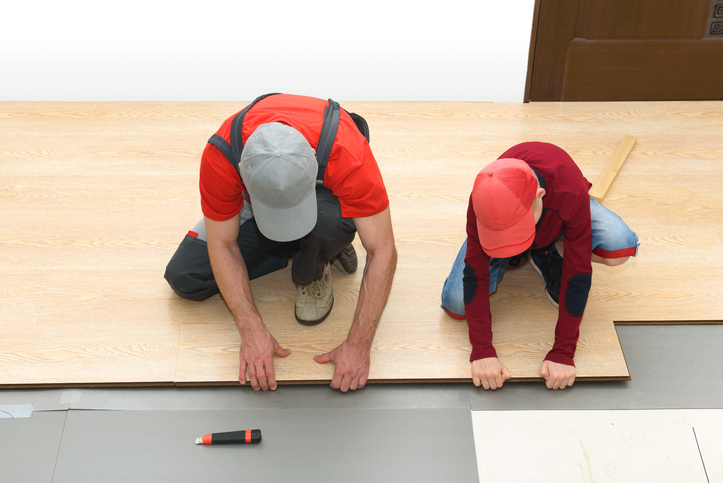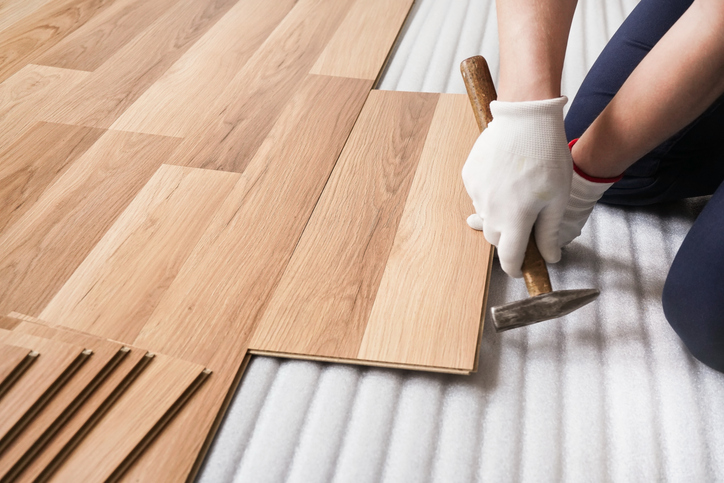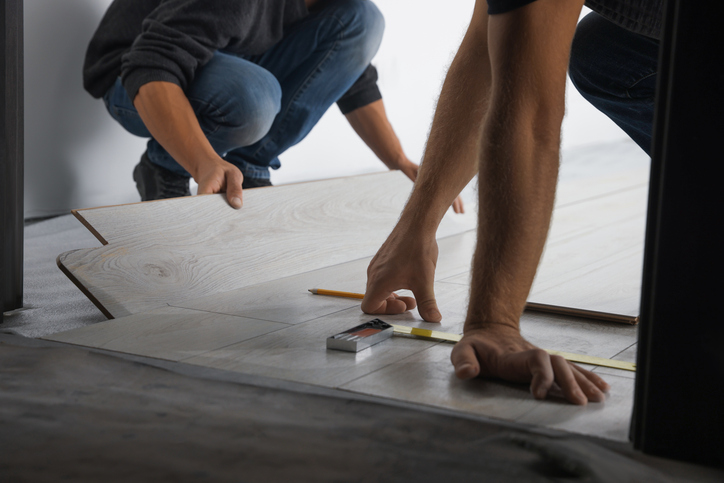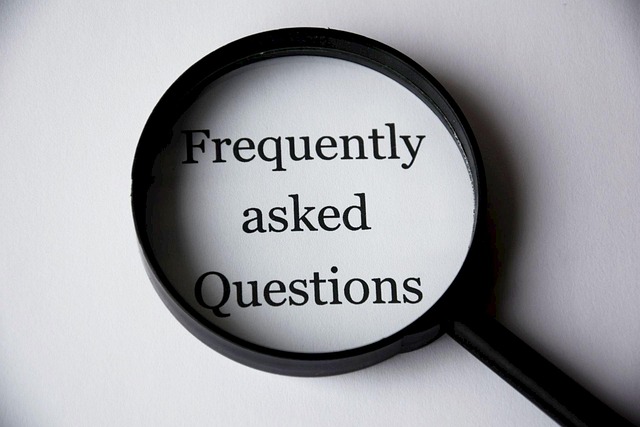Floating Engineered Hardwood: No Nails. No Mess.
May 12, 2025
Floating engineered hardwood is one of the easiest and most versatile options. This installation method offers the beauty of real wood without the mess and hassle of traditional techniques. That translates to no nails, staples, or even glue.
Want the appeal of solid hardwoods with less installation stress? Floating engineered hardwood is the ideal choice.

What Is a Floating Engineered Wood Floor?
A floating engineered wood floor doesn’t attach to the subfloor with nails or glue. Instead, the planks connect using a locking system, creating a stable surface that “floats” above your subfloor. Floating floors are convenient for remodeling projects where you don’t want to tear out existing flooring.
How Floating Floors Compare to Solid Hardwood Flooring
Solid hardwood flooring planks are just that, a single piece of wood. You must nail and even glue those planks to a stable subfloor. Nailing secures the hardwood and prevents it from moving.
Remember, wood expands and contracts. Without nails holding them in place, your floors will become loose and uneven.
Engineered hardwood flooring, on the other hand, uses layers for better stability and moisture resistance. The layers allow for expansion and contraction, letting the floor move freely with humidity and temperature changes. The flooring interlocks to form a stable and secure floor without needing glue or nails.
Engineered wood floors are ideal for floating floors, basements, condos, or over concrete slabs.
Why Floating Engineered Hardwood Makes Sense
If you’re looking for real wood floors without the complications of nails, glue, or long install times, floating engineered hardwood is the answer.
It combines the beauty of hardwood with the flexibility of modern flooring systems. A floating floor gives you the look you want with less hassle, faster results, and lasting performance.
Here’s why they make so much sense:
- Quick and clean installation: There are no nails, glue, or waiting—just a solid lock-and-click install.
- DIY-friendly: With a built-in locking system, you can assemble most engineered products step by step. You need fewer tools to get the job done.
- Subflooring: Floating installs work over plywood, concrete, or even existing wood floors. The only caveat is that the subfloor surface is flat and dry.
- Less disruption: Floating floors mean faster installs with less noise and no lingering adhesive smell.
- Durability: Engineered hardwood is made from real wood and designed to withstand changing conditions better than solid wood. Its finish, typically aluminum oxide, also provides more durability against scratches.
Do Floating Floors Require Glue?
Most floating engineered hardwood floors do not require glue to install. They use a locking system that clicks the planks together without adhesive. However, some floating floors may require a bead of PVA wood glue along the joints for added stability. That’s especially true of older tongue-and-groove styles.
Bottom line:
- Click-lock floors = no glue needed
- Tongue-and-groove = sometimes glue in the seams
Always follow the manufacturer’s installation instructions for your specific product.

Laying Floating Engineered Wood Flooring
An engineered hardwood floating installation is easier than you might think. Here’s a basic outline:
- Prep the subfloor: Clean, dry, and level is key. Remove debris and check for moisture.
- Lay underlayment: This helps reduce sound and adds comfort underfoot.
- Plan your layout: Measure and mark your starting line. Mix planks from multiple boxes for natural variation.
- Click and lock: Start in one corner and use the locking system to connect planks as you move across the room.
- Trim and finish: Cut planks as needed and add molding or baseboards to cover expansion gaps.
Most companies offer complete guides and installation instructions with every product. So whether you’re new to flooring or a seasoned pro, you’ll have support every step of the way.

Are There Downsides to Floating Floors?
Like any method, floating engineered wood floors have trade-offs.
First, they may not feel as firm underfoot as a glue-down or nailed-down floor. Second, if you skip the underlayment, some sound transfer can occur.
Third, engineered hardwood is high-quality and durable. However, it doesn’t offer the refinishing opportunities of solid hardwood, where you can sand and refinish 4-6 times.
Here’s a quick breakdown:
| Pros | Cons |
| Fast, clean installation | Slightly less solid feel underfoot |
| Installs over many subfloors | Requires a level surface |
| DIY-friendly | May produce sound without underlayment |
| No glue or nails | Limited refinishing (compared to solid wood) |
| Real wood look and feel | Not ideal for high-moisture areas |
Bruce® – Our Engineered Hardwoods Make Installation Simple
Bruce® has been crafting high-quality wood floors for generations. When you choose our engineered hardwood flooring, you’ll get durable performance and authentic style.
We offer over 150 engineered wood flooring options in ash, birch, cherry, hickory, maple, oak, and walnut. You can also choose from five finishes, including traditional, distressed, wire-brushed, hand-scraped, and smooth wood.
Remember. America is built on Bruce hardwood flooring. Find a dealer near you.
Floating Engineered Hardwood Installation FAQ
Do floating engineered hardwood floors need glue?
Not usually. Most modern floating engineered wood floor systems use locking that clicks planks together without glue. For some tongue-and-groove products, a bead of PVA wood glue in the seams may help. Always check your product’s installation guide.
Do I need underlayment for a floating floor?
Yes. Underlayment is essential for most floating engineered hardwood installations. It helps with sound control, adds comfort, and protects against moisture, especially on concrete.
Can I install a floating floor on top of concrete?
Absolutely. That’s one of the most significant advantages of a floating engineered wood floor. Just be sure to use a moisture barrier and verify that the concrete is flat, dry, and debris-free.
What subfloors work with floating floors?
Floating floors can be installed over:
- Plywood
- Concrete
- Existing wood floors
- Vinyl or tile (if flat and secure)
Just avoid installing over carpet or heavily damaged surfaces.
Can I install an engineered hardwood floating floor myself?
Yes, many homeowners do. Floating floors with a step-by-step locking system are ideal for confident DIYers. Bruce offers detailed installation guides to walk you through the process.
Will my floating floor make noise?
It can—if installed improperly. Hollow sounds or squeaks usually come from uneven subfloors or gaps in the underlayment. Use a quality underlayment and prep your surface well to reduce noise.
Is floating engineered hardwood high quality?
Yes. Floating engineered hardwood is real wood on top, with a layered core for strength and stability. It delivers a long-lasting, high-quality floor when paired with a quality locking system and installed correctly.

